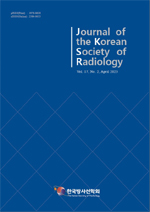
양성자치료계획을 위한 이중에너지 전산화단층촬영 잡음 제거 영상 기반 저지능비 추정 방법
Stopping Power Ratio Estimation Method Based on Dual-energy Computed Tomography Denoising Images for Proton Radiotherapy Planning
- 한국방사선학회
- 한국방사선학회 논문지
- 제17권 제2호
- : KCI등재
- 2023.04
- 207 - 213 (7 pages)
전산화단층촬영(computed tomography, CT) 영상은 양성자 브레그 피크 위치 추정 및 치료 계획 시뮬레이션의 기초로 사용된다. Hounsfield Unit(HU) 기반의 양성자 저지능비(stopping pwer ratio, SPR) 예측 과정에서 환자의 밀도와 원소 구성의 작은 차이로 양성자 빔의 경로를 따라 브레그 피크 위치의 불확실성이 발생한다. 본 연구에서는 브레그 피크 위치 예측 불확실성 감소를 위하여 이중에너지 전산화단층촬영 영상 기반의 양성자 저지능비 예측 정확도의 잠재력을 연구를 하였다. 양성자 빔의 저지능비를 추정하기 위해 전산화단층촬영 시스템(Somatom Definition AS, Siemens Health Care, Forchheim, Germany)을 이용하여 전자밀도팬텀(CIRS Model 062M electron density phantom, CIRS Inc., Norfolk, VA, USA)의 단일에너지 및 이중에너지 영상을 획득하였다. 이를 검증하기 위해 미국 국립 표준기술 연구소(National Institute of Standards and Technology, NIST)에서 제공하는 표준 데이터를 통하여 추정한 실제 저지능비와 비교하였다. 그 결과 잡음이 제거된 이중에너지 영상 기반 방법을 통한 양성자 빔의 저지능비 예측에서 정확도 개선 가능성을 확인할 수 있었으며, 인체의 다양한 밀도와 원소 구성을 가진 대체물을 더욱 다양하게 제작하여 저지능비를 예측할 경우 더욱 향상된 양성자의 브레그 피크 위치 예측이 가능할 것으로 사료된다.
Computed tomography (CT) images are used as the basis for proton Bragg peak position estimation and treatment plan simulation. During the Hounsfield Unit (HU) based proton stopping power ratio (SPR) estimation, small differences in the patient's density and elemental composition lead to uncertainty in the Bragg peak positions along the path of the proton beam. In this study, we investigated the potential of dual-energy computed tomography image-based proton SPRs prediction accuracy to reduce the uncertainty of Bragg peak position prediction. Single- and dual-energy images of an electron density phantom (CIRS Model 062M electron density phantom, CIRS Inc., Norfolk, VA, USA) were acquired using a computed tomography system (Somatom Definition AS, Siemens Health Care, Forchheim, Germany) to estimate the SPRs of the proton beam. To validate the method, it was compared to the SPRs estimated from standard data provided by the National Institute of Standards and Technology (NIST). The results show that the dual-energy image-based method has the potential to improve accuracy in predicting the SPRs of proton beams, and it is expected that further improvements in predicting the position of the proton's Bragg peak will be possible if a wider variety of substitutes with different densities and elemental compositions of the human body are used to predict the SPRs.
Ⅰ. INTRODUCTION
Ⅱ. MATERIAL AND METHODS
Ⅲ. RESULT
Ⅳ. DISCUSSION
Ⅴ. CONCLUSION
ACKNOKEDGEMENT
Reference